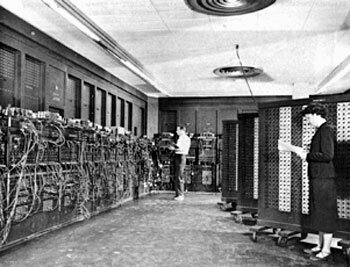| ENIAC and Pi |
|
| |
|
|
| |
ENIAC, an acronym for Electronic Numerical Integrator and Computer, was the first high-speed fully electronic general purpose digital computing machine. It was built to for the United States Army's Ballistic Research Laboratory, with its intial task being the calculation of artillery firing tables. The conept and design for ENIAC was by two computer pioneers John Mauchly and J. Presper Eckert of the University of Pennsylvania. |
 |
| |
|
| |
A massive machine which filled an entire room, contained thousands of vaccum tubes, diodes, relays, resistors, capacitors, and approximately 5 million hand-soldered joints, ENIAC weighed in just short of 30 tons. |
| |
|
| |
What was unique about ENIAC is that rather than being capable of being used for only one single purpose, it could be "programmed" (and reprogrammed) to solve a full range of computing problems. |
| |
|
|
| |
It was only natural that this landmark "programmable" computer would be put to the task of calculating pi. |
| |
|
|
| |
In 1949, John von Neumann, one of the 20th century's foremost mathematicians, and one of the the few individuals originally appointed to the Institute for Advanced Study (the original appointees have subsequently come to be colloquially referred to as the 'demigods', and inlcude Albert Einstein), set out to use ENIAC to comptue pi. |
| |
|
|
| |
Von Neumann's project set a new record for pi - with ENIAC computing 2037 digits of pi, taking 70 hours to do so. |
| |
|
|
| |
But such records are made to be broken. And the new tool of the 20th century - the computer - was precisely the tool to be used to break those records. |
| |
|
|
| |
It was only a few years later - in 1955, that the Naval Ordinance Research Center (NORC), bested the Army's ENIAC record of 2037 digits of pi calculated in 70 hours, by calculating 3089 digits of pi in only 13 minutes. |
| |
|
|
| |
And so began the intense, friendly, and at times not-so-friendly super-charged international quest to compute the 'most' digits of pi. |